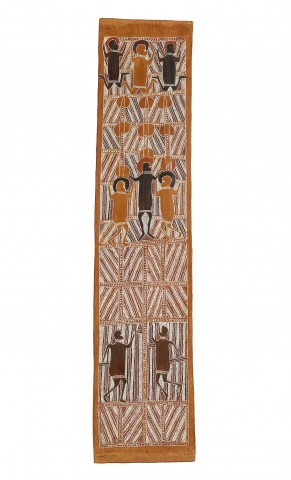SYDNEY, c.1962
MAWALAN MARIKA
natural earth pigments on eucalyptus bark
121.0 x 27.0 cm (irregular)
bears inscription verso: title ‘Sydney’, Location 'Melville Bay', language group 'Riratjinga' together with a description of the story depicted on old label
Painted in the Yirrkala region of North–East Arnhem Land, Northern Territory, c.1960
Gary Bradley, Victoria
Thence by descent
Private collection, Victoria
Open Air: Portraits in the Landscape, National Portrait Gallery, Canberra, 3 December 2008 – 1 March 2009
Sayers, A, Engledow, S., and Caruana, W., Open Air: Portraits in the Landscape, National Portrait Gallery, Canberra, 2008, p. 14 (illus.)
Mawalan Marika was one of the exceptional ceremonial leaders of his generation who witnessed the encroachment of foreigners onto his country and bridged the gap between Aboriginal and European Australian societies. His main medium was art. An innovative and highly influential artist, he painted countless ancestral and ceremonial images, as well as taking a lead role in the painting of the renowned Yirrkala Church Panels in 1963. Mawalan also used painting as a means to record his personal experiences in a changing world and Sydney, c.1962, is one of the few autobiographical works that records his visit to a large urban centre. In fact, Mawalan was one of the first Yolngu to travel interstate when, in 1961, he flew to Sydney to participate in the exhibition Art from Arnhem Land at Qantas House.
Mawalan recorded this extraordinary experience in a number of bark paintings. One, in the collection of the National Museum of Australia, depicts Sydney from the air.1 Buildings, houses, roads and the profile of Sydney harbour must have presented an awe-inspiring view for the artist who had not travelled further than the ‘Top End’ of the Northern Territory. Another bark painting features two rows of people walking along opposite sides of a street in a rectangular matrix of clan designs, dotted lights and windows.2
Sydney, painted in or about 1962, offers a more arresting expression of the artist in a large, bustling city full of people and big buildings, quite the opposite of the small community of Yirrkala in north east Arnhem Land that was his home at the time. Mawalan’s painting features a throng of people wearing hats walking along streets lined with bright lights. The images are arranged in a conventional Yolngu compositional grid, where the lines of dots ‘create an impression of the shimmering city at night,’3 and the ground consists of variations on the Rirratjingu clan pattern. The painting brings to mind the iconic image of an Australian city by John Brack (1920-99), Collins St, 5pm, painted some six years earlier and now in the collection of National Gallery of Victoria. While Brack’s setting is Melbourne, not Sydney, the paintings present comparable but differing attitudes to viewing crowded streets. Brack’s version is slightly detached, observing the passing parade as if through a window. In contrast, by positioning himself ‘in the street’, Mawalan produces an engaging image that expresses his amazement at facing long lines of people, so much so that he described them as three devil-devils with tall head gear.
1. Sydney from the air, c.1962, is illustrated in Caruana, W., Duff, A., Morphy, H., & Taylor, L., Old Masters: Australia’s great bark painters, National Museum of Australia, Canberra, 2013, p. 156, and in Morphy, H., Aboriginal Art, Phaidon, London, 1998, p. 40, plate 22, under the title Map of Painter's Travel by Plane from Yirrkala to Sydney.
2. A trip to Sydney, n.d., is illustrated in Allen, L. A., Time Before Morning: Art and Myth of the Australian Aborigines, Thomas V. Crowell, New York, 1975, p. 25.
3. Morphy 1998, p. 37.
WALLY CARUANA
